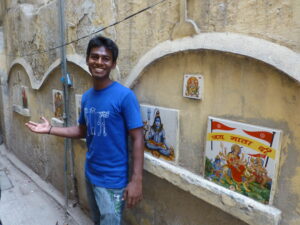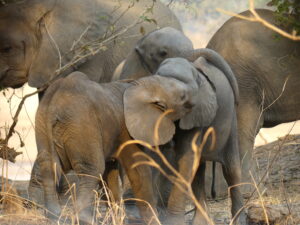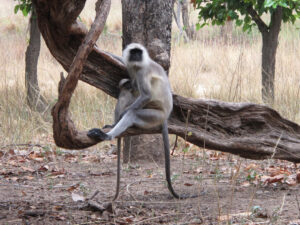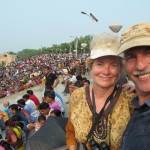
There are three principal sites tourists visit in Amritsar. Though related only in geography, all three are distinguished by notable incidents of violence in the past, while perhaps also sharing the hope for peace.
One is the Wagah border crossing between Pakistan and India, the site of an evening display of militarism surrounding the lowering of their two flags at the gate. The second is Jallianwala Bagh, a memorial park honoring the Indians who were swept by British gunfire and killed during a peaceful protest in 1919. The third is the epicenter of the Sikh religion, Sri Harmandir Sahib, which the British called the Golden Temple. Always a place for prayer, it too has seen great violence in its past.
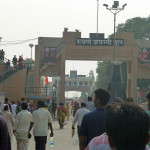
To start at the border, each night thousands of Indians travel 45 minutes or so on National Highway 1 from Amritsar to Wagah, joined by handfuls of foreigners. We stop at a barrier across the road, where the gates open about 5pm so all can walk that last kilometer to the actual border. On the Pakistanis’ side, past their own buffer zone, National Highway 1 continues on to Lahore, as it did before partition in 1947.
The Indian citizens flood through on the right side of the road. Meanwhile, oddly, the trickle of foreigners is channelled to the left side of the road, along with Indian VIPs, whose names are confirmed on clipboards as if they were trying to enter a Manhattan music venue.
All of us flow into a sort of arena looking over at the border gate at the last 100 meters or so of the Highway. The Indians fill up the end-zone space, so to speak, and concrete stands alongside the road. The foreigners are squeezed into the leftmost section of the stands closer to the gate. The VIPs fill in prime seating at the virtual 40 yard line, as do their counterparts on the Pakistani side.
Atop the gate, the two flags of these often antagonistic and warring countries shifted in the slight breeze. Militaristic music and admonitory announcements squawked loudly and competitively over the speakers, courtesy of BSF – the Border Security Force charged with the protection of the border from incursion.
Soon the stands on the Indian side overflowed. All seating space was filled and many lined the road section near the gate. Surprisingly, on the Pakistani side, we saw surprisingly few people in the stands, divided into male and female, though we’re told those are often filled as well.
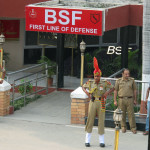
And it was hot and steamy in the unshaded stands in the late light. Everyone was sweaty; our clothes became so soaked we were literally dripping puddles around us and imprinting the concrete rows with moist images of our butts. Only the BSF soldiers, in their starched brown uniforms and rooster-crown red headgear, and the Pakistani soldiers in their own black uniforms, seemed impervious to the heat.
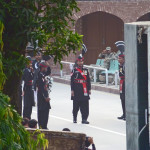
Why are all these people here? Most apparent is the ritual display of national strength demonstrated by the soldiers, representatives of those who fought actual wars with each other after the partition.
Secondly, a celebration of national pride in the form of their military prowess, a celebration not unlike that at an athletic contest. In the hour before the ceremony, the music seemed to stir the crowd to sing the praises of the country. Flags waved from the stands. Soon, cheered on by the crowd, several women, then young boys and a few older men took turns trotting up to the border gate, waving a saffron-white-and green Indian flag as large as they were.
The last purpose to be here was an occasion to party. As the music shifted to popular tunes, women came down from the stands to fill out an impromptu mosh pit, dancing like apsaras in colorful saris. A few of the foreign women joined them – briefly – soon wilting in the heat. In the stands, families chatted, snacked and sang along as they wished. (See video below)
But the ritual is the attraction. About a dozen of the red-topped soldiers, unsurprisingly synchronized with their Pakistani counterparts, strut and high-kick individually or in groups up to the border gate. There, to the cheers of the crowd, the soldiers flex their muscles and stare menacingly at each other. It’s a ritualistic taunting familiar in sports as well. (See video below)
With the gates open, the opposing forces – wait for it, wait for some more music and posturing – cross the ropes that lower the flags, and again in sync bring them down past each other. Soldiers quick march away as the gates close till the next night. Those in the audience, glistening with sweat, disperse. (See video below)
What we don’t see, according to a friend who visited during the day, is the more cordial camaraderie shared by the Pakistani and Indian soldiers stuck at this outpost. For all the ritual of warfare in the evening, by day they are just as likely to be sharing some tea with each other as carrying out any military duties.
And perhaps that’s what the crowd is really celebrating, that active warfare between the two countries perhaps can stay in the past. For now we can all come to the border – Indians, Pakistanis, foreigners, VIPs – wave flags at each other, and party, in the name of shantih, shantih, shantih, the Sanskrit word for peace.

Jallianwala Bagh is now a place for less boisterous enjoyment, a small park with walking lanes and grassy resting spots. Its red flame-like monument and bullet-scarred walls, however, recall a bloody massacre of 500 to 1000 Indians in 1919. British soldiers fired on unarmed protesters against religious restrictions, as well as Sikh pilgrims gathered at this site. The reaction in India and in Britain helped stir Gandhi and others to continue their non-violent resistance to colonial rule (the massacre was re-enacted in the movie “Gandhi”). Occasionally, important Brits – like Queen Elizabeth and David Cameron – perform their own ritual, laying a wreath in regret.
Rites of a far different sort from those at Wagah fill the Sri Harmandir Sahib, with the aim not of confronting the borders that divide people, but of bridging the gaps among them and to God.
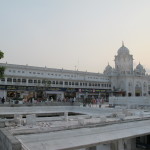
The Golden Temple is the Vatican for the Sikh religion, its principal gurdwara, its spiritual and administrative center. All Sikhs try to make a pilgrimage here at least once in their lives. The constant stream of devotees entering the main/eastern gate (and the hundreds lined up throughout the day at the inner temple) made it clear how many were doing their pilgrimage now. We happened to speak with a man from New Jersey who would continue to visit the temple at dawn for forty days during his pilgrimage here.
The Sikh religion began, as an earnest middle-aged Sikh in the visitor office explained to us, in the 16th century. Its founder was reacting somewhat against the misguided ways of Hinduism and Islam (Hinduism’s many gods, not one; social stratification, not equality; acceptance of other religions; etc.). Sikhs, he added, embrace the secular and material world (which explained to us the large clocktowers above the gates), and are obliged to deal honestly with people.
Though focused on unity and peace, Sikhism and the temple proved surprisingly militaristic in its history and heroes. We heard from our guide about Baba Deep Singh, the leader of rebellion against the Mughals, who reputedly held his nearly severed head in place while leading his troops against overwhelming forces. Perhaps in tribute, in the temple complex some very tall Sikh men carrying long spears benignly help ensure order and the rules are followed.
More recently in 1984, there was a bloody standoff between Indian military and a band of Sikh protesters/rebels for independence holed up in the temple complex. In echoes of Jallianwala Bagh, the Indian military bombed the buildings sheltering the rebels. Listening to the story, we couldn’t help but recall the sad history of the partition (with the subsequent wars and religious conflict) that created the Wagah border crossing we had just seen.
So far, though, the Golden Temple seemed anything but golden. The eastern side of the complex is a half-kilometer long multi-story arcade of white marble and wood, with stalls offering items for sale or services to visitors. A small gold dome peaks over it. In the center of the arcade rises a tall white clocktower, one of four gateways to the interior courtyard, symbolic of Sikhism’s openness to all people. Architectural elements appropriately draw from Hindu and Muslim architecture.
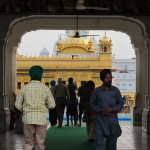
The gold, we found, as we donned our saffron head coverings and washed our feet in the bordering pool, is at the heart of the complex. Framed by the tall entrance, a rectangular block of gold plating gleams atop a marble base. Surrounding it and reflecting it is a huge rectangular moat of holy water, itself surrounded by broad marble walkways and the rectangular array of four marble arcades and gateways like the one we entered.
The rites enveloped us, as we walked around the moat, in the form of constant prayers, music and chants coming from the loudspeakers. More physically, the devout dipped themselves in the waters at the baptismal steps at the south end. We passed a shrine honoring the headless warrior, where many stopped to pray.
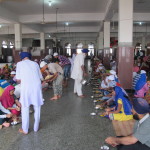
Also at the south end, a more pragmatic ritual – a free meal service to all who enter – takes place in a large warehouse-like brick building. It exemplifies the Sikh spirit of sharing – whether it be knowledge like our guide shared with us or food. Visitors – we estimated a few thousand per hour – take metal plates and cutlery and proceed into one of the two levels of dining halls. There all sit together on long rows of unfurled mats. Many volunteer in the effort. The food emerges in a steady procession from a large side room where cooks tend huge pots of food. A cadre of servers dish out breads, lentils, rice, and veg curries. On the ground level, innumerable men and women line rows of basins to wash the dishes, while others sit on the ground meticulously prepping onions and garlic.
At the opposite northern end, the administrative center houses the day to day leadership of the religion, where just the day before a trio of Sikhs had been excommunicated.
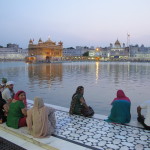
But the rite that surrounded us from the loudspeakers comes from the center of all this, the Harmandir itself, accessible only from the north by a long golden causeway. Here is where the text of the sacred book, the Adi Granth, is read and sung without stop from dawn till long after dusk. At that point the huge book is returned ceremoniously and joyously atop the outstretched arms of devotees to the admin buildings. The book is apparently as central to the religion as the Torah is to Jews.
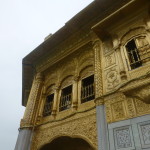
To visit the golden center, we waited for about a half hour, slowly moving along the causeway. We marvelled at the exterior’s ornate workmanship of flowers and plants and animals, displayed both in the gold above and in the elegant marble inlay below.
Pilgrims filed in with us to pay respects through prayer or sit with others at one of the halls where the three open prayer books sat, while the texts were chanted. One twisted man on crutches lay down on the floor to humble himself in prayer. The principal book, the only one copied by hand, sat amidst a compact, but richly ornate hall decked in gold trim, glass inlay and elaborate patterning.
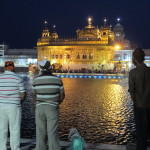
As we left, the reading must have reached a particularly important part of the book. All secular activity and movement around the walkways stopped as thousands of visiting Sikhs faced the golden temple on the causeway or at the edge of the moat. Each raised hands in prayer, responding loudly to the calls of the lead chanter on the loudspeaker. The four walls of the complex echoed with their devotion, seeking perhaps for shantih, peace.
(Also, for more pictures from India, CLICK HERE to view the slideshow at the end of the India itinerary page.)



